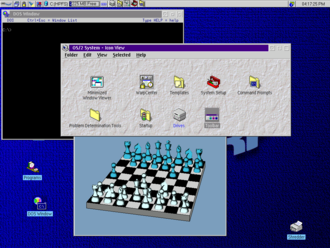What is Operating System/2 (OS/2)?
"We believe that OS/2 is the platform for the 90s."
— Bill Gates
OS/2 stands for Operating System/2. IBM and Microsoft developed MS OS/2 in 1987, the first version of this 16-bit multi-tasking system that was intended to replace and Windows 3.x. Microsoft took part of the code to develop Windows NT 3.x. IBM continued with the development of OS/2 till 1997/2000 releasing versions 2 to 4, which are 32-bit systems. Version 3 and 4 were released under the name OS/2 Warp.

My experiences with OS/2 are limited to Warp 3 (1994), which is probably one of the ones I have ever had with any OS. It never crashed on me and that is more than I can say about every other OS that I have ever used other than DOS. OS/2 has the same feeling as Windows 3.11 or Linux 1.3 with a chunky taskbar floating on the screen. OS/2 Warp 3 came in two flavors — blue and red spines. The red spine version fully supported installing Windows 3.11 under it and the blue spine offering no support.
By 2000, the development of this project was picked up by Serenity Systems International under the name eComStation, which kept its GUI similar to the X Windows System.
On 12/2005, IBM discontinued the development of OS/2. Many people think that the lack of interest to this OS is the result of weak North American promotion. OS/2 is more popular in Europe than in the US. Many of the sites that I have visited are in Russia and/or Germany.
On 11/2015, Arca Noae (project Blue Lion) as a distribution based on OS/2 Warp 4 under license from IBM — not based on eComStation.
On 04/2017, Blue Lion was released as ArcaOS 5.0 (OS/2 5.0). There is no clear explanation what is going to happen to license and production of eComStation with the licensing and release of ArcaOS 5.0. Perhaps OS/2 will become the next Linux, where multiple companies and/or organizations can release custom distribution as long as IBM signs of the proper license.
